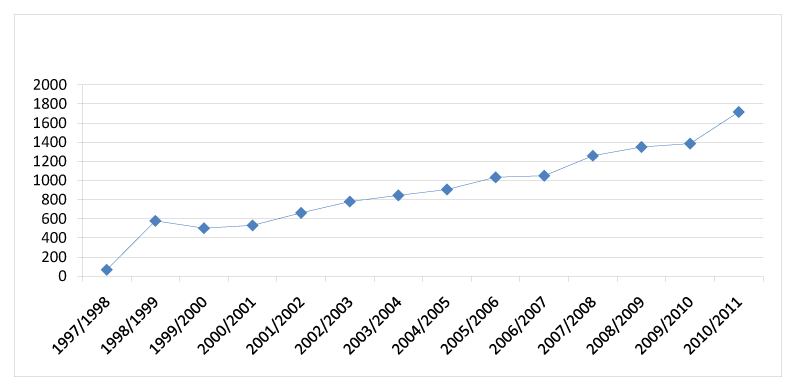
No. of patients visited the radiotherapy center versus years
Figure 1: The No. of patients visited the Radiotherapy Oncology center from 1997/1998 up 2010/2011

Wondemagegnhu Tigeneh1* Abera Molla1 Ayenalem Abreha2 Mathwose Assefa2
1
Oncology Center, Medical faculty, Addis Ababa University, Addis Ababa, Ethiopia
2Radiotherapy Center, Addis-Ababa-University, Addis Ababa, Ethiopia
*Corresponding author: Wondemagegnhu Tigeneh, Oncology Center, Medical faculty, Addis Ababa University, P.O. Box 3819, Addis Ababa, Ethiopia, Tel: 251 9118 97356; E-mail: tigeneh@yahoo.com
Article Type: Research Article
Citation: Tigeneh W (2015) Pattern of Cancer in Tikur Anbessa Specialized Hospital Oncology Center in Ethiopia from 1998 to 2010. Int J Cancer Res Mol Mech Volume 1.1: doi http://dx.doi.org/10.16966/ 2381-3318.103
Copyright: ©2015 Tigeneh W. This is an openaccess article distributed under the terms of the Creative Commons Attribution License, which permits unrestricted use, distribution, and reproduction in any medium, provided the original author and source are credited.
Publication history:
During the Last two decades the incidence of cancer has increased in an ascending pattern worldwide. The type and pattern of cancer varies with between geographical region location, people’s life style and socio-economic development status of a given country. Some types of cancers are more common in the developed world and others occur more frequently in developing countries. It is expectable that with increase in life expectancy, adapting western life style and increasing growth of industrialization, the burden of cancer in sub-Saharan African countries is likely to increase in the new millennium.
Objective: The objective of this study is to identify the pattern and type of cancer in Ethiopia based on the hospital registry for the last 14 years from 1998 up to 2010 in the only Oncology Center for the country in Tikur Anbessa Specialized Hospital.
Methodology: This is a retrospective study aims to determine the pattern of cancer based on hospital registry in Tikur Anbessa Specialized Hospital, Oncology Center. All data was carefully reviewed from the registration log book, if any inadequate information was counter checked from the file and excluded from analysis if proven to be in adequate. Any correction or additional information of data was done based on the file and then SPSS statistical package was used to analyze the pattern of cancer, type and other variable.
Result: According to our study we found that 72.8% are females and the rest 27.2 % are males. Among all patients only 10% of patients did come to the center in early stage I and II. The most common malignancy in female was gynecological malignancy 47% followed by breast carcinoma 26%. Ca uterine cervix found the most common malignancies among all gynecological malignancies. Head and Neck malignancy is found to be the leading malignancy in male 22% followed by sarcoma 15%, Gastrointestinal 12%, Hematology malignancies and urogenital 9% each and Thyroid 5%.
Conclusion: Cancer has been increasingly recognized as a critical public health problem in Ethiopia, Despite this increasing burden, cancer continues to receive low public health priority in Africa, largely because of the overwhelming burden of communicable diseases and limited resources. In this study summarized the available information on cancer occurrence in Ethiopia, this should be helpful to raise cancer awareness and promote cancer prevention and control in this country. We highly recommended establishing functional population-based cancer registries within the country to facilitate cancer control strategic plan and to improve insight to policymaker about pattern and type of cancer
Pattern of cancer in Tikur Anbessa Specialized Hospital Oncology center in Ethiopia from 1998 to 2010
Types of cancer; Ethiopia; Oncology
Cancer is predicted to be an increasingly important cause of morbidity and mortality in few decades, in all regions of the world. The forecasted changes in population demographics in the next two decades mean that even if current global cancer rates remain unchanged, the estimated incidence of 12.7 million new cancer cases in 2008 [1] will rise to 21.4 million by 2030, with nearly two thirds of all cancer diagnoses occurring in low and middle income countries [2]. Despite this growing burden, cancer continues to receive low public health priority in Africa, largely because of limited resources and other pressing public health problems, including communicable diseases such as Acquired Immune Deficiency Syndrome (AIDS)/Human Immunodeficiency Virus (HIV) infection, malaria, and tuberculosis. It may also be in part due to a lack of awareness about the magnitude of the current and future cancer burden among policy makers, the general public, and international private or public health agencies.
Epidemic of cancer has transited beyond the geographical boundaries of countries. The globe is under the clutch of this dreadful disease which is spreading rapidly. Similar to the differences between Africa and the developed world, cancer incidence and mortality patterns vary remarkably across regions within Africa because of the substantial regional differences in economic development and social, cultural, and other environmental factors, including major known risk factors. Some cancers are more common in people in the developed world others occur more frequently in people who live in developing countries. Others certain types of cancers are common in both already developed countries and undergoing economic development [3]. These regional differences might be explained by genetic differences among populations, variations in lifestyles, environmental exposures and other risk factors. This assumption is reinforced by migration patterns that show that incidence of cancer among migrants’ changes to more closely & reflect the rates in the adoptive country. This has been observed with the incidence of colon cancer in Japanese people emigrating to Hawaii and San Francisco [4]. Additionally, the incidence of prostate and breast cancers are low among Chinese people in Asia, but increases have been observed when these people move to the United States of America [5].
Several migrant studies have documented that cancer rates in successive generations of migrants shift in the direction of the prevailing rates in the host country, suggesting that the international variations in cancer rates for most cancers largely reflect differences in environmental risk factors (including lifestyle and culture) rather than genetic differences [6,7]. In general, smoking, dietary patterns, and reproductive behaviors have been known to be the major risk factors for cancer in western countries, and infectious agents said to be the commonest risk factor in economically developing countries. However, currently one can see these patterns are changing rapidly. While smoking prevalence is declining in economically developed countries, it is increasing in some developing countries in South America, Asia, and Africa [8].
Cancers that once were rare and considered the diseases of western countries, such as colon, breast, and lung cancers, are now frequently diagnosed in less developed or economically transitioning countries and their rates are on the rise [9]. In addition to the increasing trends, the future burden of cancer in the developing world is likely to be exasperated by the expected increases in life expectancy and aging and growth of the population [10]. The proportion of cases diagnosed in less developed countries is projected to increase from about 56% in 2008 to more than 60% in 2030 [11]. It is also projected that cancer will surpass ischemic heart disease as the leading cause of death worldwide in 2010 [12].
In Ethiopia where oncology practice is so young, awareness’ even among medical professionals about oncology is much inferior than expected. In Ethiopia like most of sub-Saharan Africa countries doesn’t have cancer registry. As far as we know there is no study or report done mentioning the type and pattern of malignancy in Ethiopia. The Ethiopian oncology service in organized way was started in Tikur Anbessa Specialized Hospital since 1998 Ethiopian calendar, and the record was covered since then. The current study designed to assess the pattern of cancer in Oncology center in Ethiopia based on Hospital registry and to analyze the correlation of type of malignancy with age, sex, stage and region.
This is a retrospective study to analyze the data recorded in Tikur Anbessa Specialized Hospital Radiotherapy Oncology Center for 14 years from 1998 up to 2010. The data from the registration book was checked, selected those included in the inclusion criteria’s and feed to excel and transferred to SPSS to analyze the type, the pattern, and other variables.
All patients registered with full information including age, sex, diagnosis, stage, Region, in the registration book or in the chart are considered to be eligible for the study.
Patients registered but with insufficient information about one of the following vital variables like age sex, diagnosis, stage, region, either in the registration book or in the file are not eligible
Applied to the AAU MF - IRB office and had Ethical approval and permission to do the study. According to the schedule the data transfer from the registration book to database SPSS was done, and incomplete data was checked from the patient file for those the file were available. Data was analyzed accordingly and show’s as below
A total of 13, 451 patients were registered in main registration book, out of them 780 patients were excluded because of insufficient information and found difficult to analyzed. The rest all 12,671 patients were analyzed. According to this particular study from analyzed 12,671 patients found 72.8% (9229) are female and the rest 27.2 % (3442) are male.
The radiotherapy oncology center based on hospital based registration started to see and evaluate patient in organized way since 1998, and the number of patients were only 67, subsequently the number of new patients coming for evaluation and assessment was increased in ascending pattern and reach about 1717 in year 2010/2011 (Figure 1).
According to this study most of patients stated that they are from Addis Ababa, followed by Oromo, Amhara, South people and Tigray. Patient from Harer/DereDawa, Benshangul and Somali regional state were very few, there were list of patients didn’t specified there address and level as unknown. According to this study the number of patients’ visited Tikur Anbessa radiotherapy center decreased inversely proportional to the distance from the center (Figure 2).
As demonstrated below cancer was affected all group of patients. Most of pediatric age group patients were treated in pediatric department. Selected pediatrics patients who need radiotherapy treatments only sent to the department, we think that the most possible reason why the incidence pediatric patients were found as low as 1%. In other side most of the patients are found in productive age group between age 40 to 50 (Figure 3).
Even though the reason of delay in diagnosis is beyond the scope of this study, we found that most of the patients are coming to the department in locally advanced or metastatic stage. In registration book most of the patients after surgery registered as postoperative without stated stage and make it difficult to categorize accordingly. There are group of patient (32%) found to have stage III and IV almost equal amount of patients came after different type of surgery. As you see below on figure 4 only 10% of patients did come to the center in early stage I and II (Figure 4).
The first fourteen top cancer among registered in the registration book was shown below in Figure 5. Gynecology malignancy is found to be the leading malignancy which covers 36.6%. Uterine cervix, ovary, endometrium and Vulval ca are among malignancies listed under the gynecology malignancy. Breast cancer is found to be the second most common malignancy. Both the Gynecological malignancy and cancer of the breast make a total of 58.86 % incidence. Head and Neck cancer, sarcoma, gastrointestinal, Thyroid, urogenital, Skin, CNS, Lung, Orbital, CUP are type of malignancies listed down according to their incident rate. Thyroid cancer was analyzed separately even though it’s found in the head and neck area because of the biology of the tumor is totally different from head and neck malignancies.
According to our registration and survey Head and Neck malignancy was found to be the most common malignancy in male followed by sarcoma (both soft tissue sarcoma and osteosarcoma), Gastrointestinal (GI- which include Esophagus, stomach, colorectal, anus, liver and pancreases) , Hematology malignancies (mostly Lymphoma HL, and Multiple Myeloma) and Thyroid as shown below (Figure 6).
According to registration among female patients Gynecology malignancy is the leading malignancy and it covers almost 47%. Under gynecological malignancies we included mostly uterine cervix, ovarian, endometrial and vulva cancer. After gynecological malignancies breast, H and N, Sarcoma and thyroid / GI malignancy were followed in sequential order (Figure 7).
Cancer is the leading cause of death in economically developed countries and the second leading cause of death in developing countries [13]. The burden of cancer is increasing in economically developing countries. The possible reason are a population aging, an adoption of cancer- associated lifestyle, exposure to different infections, including smoking, physical inactivity, and ‘‘westernized’’ diets. Regardless of all this, Cancer has received low priority for health care services in Sub-Saharan Africa. The reason is undoubtedly the overwhelming burden of communicable diseases, as illustrated by the proportions of deaths by major categories [14,15]. In Africa health care provider gave major attention to the infant and child mortality, maternal mortality and infectious diseases which was solved in the developed world. Unfortunately, these “old” diseases coexist in Africa with the emergence of new ones, most prominently the Acquired Immune Deficiency Syndrome (AIDS), but also some of the non-communicable diseases (NCD), such as hypertension, diabetes, accidents and violence [15], and cancer make it difficult to control. The NCD, such as cancers, are emerging health problems that need to be dealt with appropriately to sustain public health advances that have already been achieved.

No. of patients visited the radiotherapy center versus years
Figure 1: The No. of patients visited the Radiotherapy Oncology center from 1997/1998 up 2010/2011
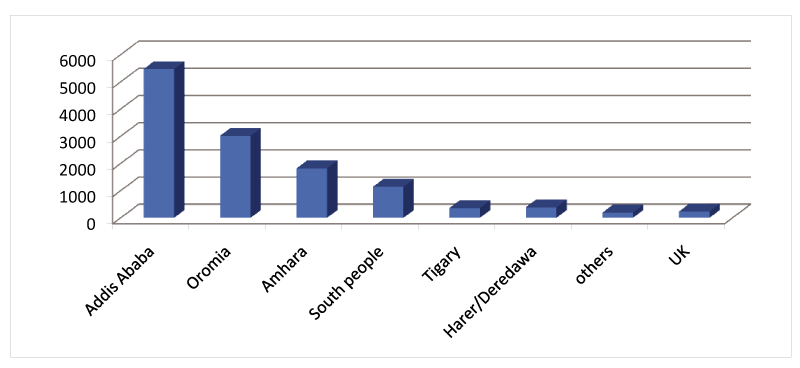
UK – Un known; Other – Benshangul, Gambela, Somali regional state
Figure 2: Patients in relation to their residence area
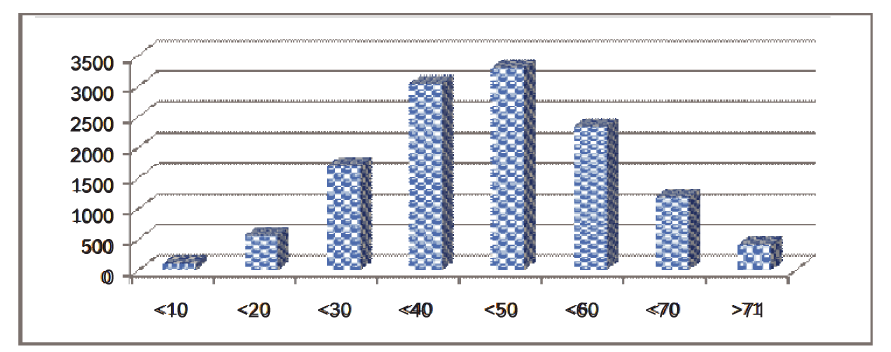
Figure 3: The incidence of cancer in different age group
A total of 57 million deaths occurred in the world during 2008; 36 million (63%) were due to NCDs, principally cardiovascular diseases, diabetes, cancer and chronic respiratory diseases [16]. Nearly 80% of these NCD deaths (29 million) occurred in low-and middle-income countries. NCDs are the most frequent causes of death in most countries in the Americas, the Eastern Mediterranean, Europe, South-East Asia, and the Western Pacific. In the African Region, there are still more deaths from infectious diseases than NCDs. Even there, however, the prevalence of NCDs is rising rapidly and is projected to cause almost three-quarters as many deaths as communicable, maternal, perinatal, and nutritional diseases by 2020, and to exceed them as the most common causes of death by 2030 [17].
NCD in Ethiopia considered as health problem starting from last decay. According to Tikur Anbessa specialized hospital statistical data in 2010/2011 neoplasm is one of the first admission diagnosis followed by, diseases of the circulatory system, diseases of the nervous system, Diabetes mellitus, disorders of the genitourinary system, diseases of the digestive system, diseases of the musculoskeletal system and connective tissue, diseases of the respiratory system, Trauma (injury, fracture etc.), Hypertension and related diseases. According to the Hospital registry in radiotherapy center the incidence of neoplasm from 1998 increasing every year, as you see from the figure 1. The number of patients increased dramatically from 1997/1998 every year and reached around 2000 new patient per year 2010. According to our hospital registry females are more affected than male unlike in Egypt observed male predominant [19]. In that particular study [19] men had higher incidence than women for all common cancer sites but the highest differences were observed for cancers of the larynx, bladder, liver and lung.
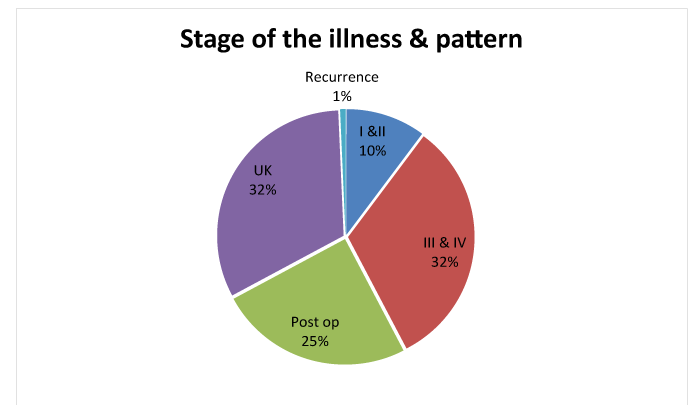
UK – Unknown, KS – Kaposi Sarcoma, GI Gastrointestinal tumor, CUP – Cancer of Unknown Primary, Other – different malignancies in small numbers
Figure 4: The frequency of patients by stage
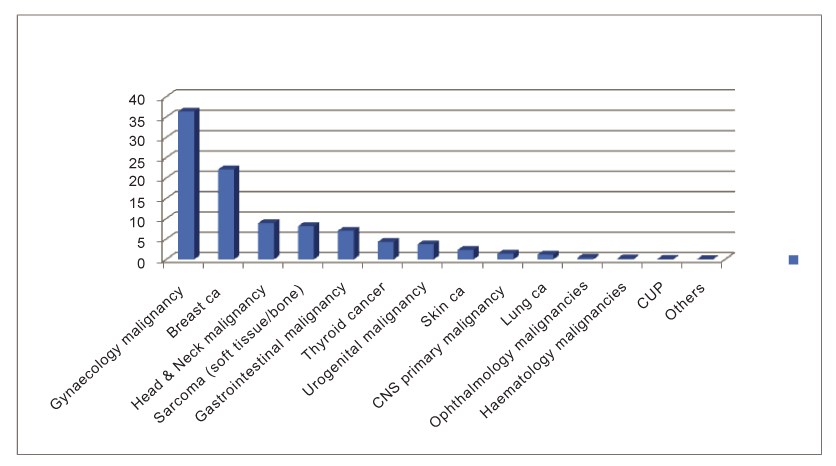
Figure 5: Type of cancer and incidence among of patient evaluated for the 14 years
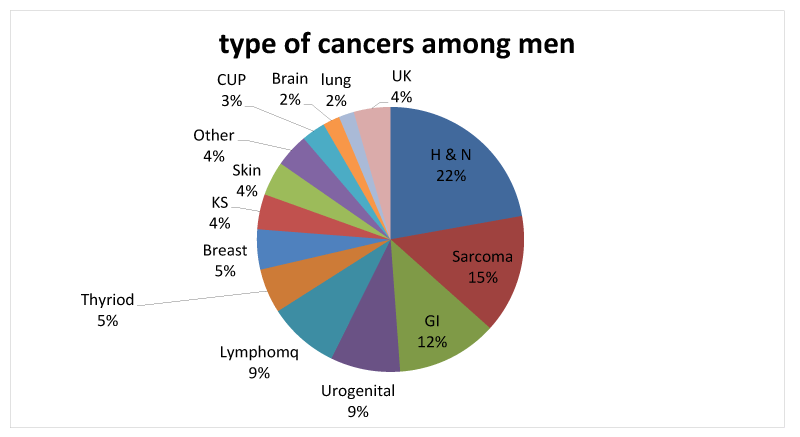
UK – Unknown, KS – Kaposi Sarcoma, GI Gastrointestinal tumor, CUP – Cancer of Unknown Primary, Other – different malignancies in small numbers
Figure 6: The commonest cancer among men
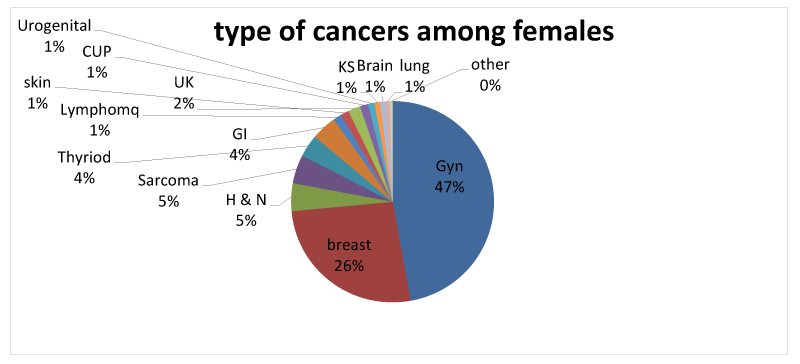
Figure 7: The commonest cancer in female
Study showed that cancer registration is growing in Nigeria with many of the HBCR [18] (Hospital Based Cancer Registry) reported. Over the 2 years covered by this report, about 6000 new cancer cases were reported by 11 hospital based cancer registries in Nigeria. The commonest cancer in women was breast cancer. While prostate cancer was the commonest cancer in men. Colorectal cancer is the 2nd commonest cancer in males but the proportion is substantially less common compared to prostate cancer. The 3rd and 4th commonest cancers in men are lymphomas and liver cancer.
According to our hospital registry the first six common type of malignancy for male are head and Neck cancer, followed by sarcoma, Gastrointestinal (GI), Urogenital, Lymphoma, and Thyroid and the first six malignancies among females were found gynecological malignancies, breast, Head and Neck, sarcoma, Gastrointestinal and thyroid.
Major Cancer Types in Sub-Saharan Africa, both Sexes, according to Ferlay et al. [17] Show’s as follow. The top six cancers in males were: Kaposi’s sarcoma (15.9 percent), liver (13.3 percent), prostate (10.7 percent), esophagus (6.0 percent), non-Hodgkin’s lymphoma (5.8 percent), and stomach (4.5 percent) which is not correlated with our data.
In females, the following were the leading cancers: cervix (25.4 percent), breast (17.4 percent), Kaposi’s sarcoma (6.2 percent), liver (5.5 percent), stomach (3.8 percent), non-Hodgkin’s lymphoma (3.8 percent), except the Kaposi sarcoma the data correlated with our data in the first leading malignancies.
In fact, oncology in Africa seems to be a branch of the medicine that is practiced only by the local traditional healers, procuring devastating effects on the natural history of the tumors. Generally, cancer is mystified, preventative actions are not taken and treatment engagement is deficient. As much as 95% of cancer patients in the African countries are diagnosed at late- or end-stage disease [19,20]. The delayed diagnosis for these patients is due to the low level of cancer awareness between the population and the health workers, culture and constraints on access to specialized care, usually nonexistent in these countries [17].
A majority of cancers in Africa are diagnosed at an advanced stage of disease because of lack of screening and early detection services, as well as limited awareness of early signs and symptoms of cancer among the public and health care providers. Stigma associated with diagnosis of cancer also plays a role in late-stage presentation in most parts of Africa. According to our analysis most of the patients presented in our oncology center are either locally advanced, metastatic or unknown stage (64 %) when we compare with early stage (10 %) and the rest 25% was level as unspecified postoperative.
The cancer incidence in Africa has been increasing dramatically, especially after the onset of AIDS pandemic. The rapid rises of neoplasms incidence in Africa may be only partially attributed to AIDS epidemic which, however, cannot account for all the observed increases, as subtypes not associated with AIDS are continuing to increase [21].
In Africa, the cancer problem is related not only to the underestimation of the tumors incidence but also to the low level of cancer knowledge and awareness in the health workers and general population that had had devastating consequences. In Ethiopia In fact, it was estimated that 88% -95% of people with cancer in Africa are diagnosed at late- to endstage disease [19,22,23]. For people with a cancer diagnosis, the chances of surviving are very low so that incidence and mortality are usually represented by closed data. This is due to cancer drugs unavailability, radiotherapy centers shortage and scarcity of trained manpower. The manpower must include oncologists, pathologist, oncology surgeons, radiologists, palliative care physicians as well as other supportive stuffs like nurses, social workers and supportive stuffs.
Because of no cancer registry in Ethiopia, the exact number of cancer incidence or prevalence is not known, so accommodating the WHO or IARC data will be without alternative. In this particular study because of insufficient information from registration book around 800 patients excluded from analysis. Functional population-based cancer registries within the country will solve the problem and facilitate cancer control strategic plan and will improve insight to policymaker about pattern and type of cancer [24].
We want to thank staffs of Tikur Anbessa Specialized Hospital Radiotherapy center for their contribution and support during the study period. Special thanks go to Mrs. Embet for collecting data and filling the forms’ on hospital registry which was the source of this particular study. We like to appreciate Mr. Nemi his contribution for unrestricted willingness and assistance to arrange the patients file when it was necessary.
The authors declare that they don’t have any conflicts of interest that might inappropriately influence their work, this article.
Download Provisional pdf here
All Sci Forschen Journals are Open Access